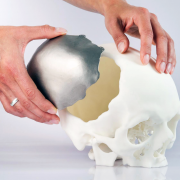Man’s Livelihood Restored by EU’s Approval of 3D Printed Cranial Implant
Though, in the past, traditional manufacturing has been used to create custom implants, 3D printing has a far greater capacity for making complex and elaborate shapes, without the need for manual work performed by surgeons in the midst of a procedure. 3D printing, then, can save time and money during the production of personal implants. Combined with the benefits of tailoring custom implants to the exact specifications of an individual’s anatomy using medical scans, 3D printing stands to revolutionize the medical industry. In August of this year, manufacturer of high-performance biocompatible 3D printing materials Oxford Performance Materials was able to gain FDA approval for its 3D printed facial implants. Now, on the other side of the world, the EU has passed their own approval of 3D printed cranial implants.



